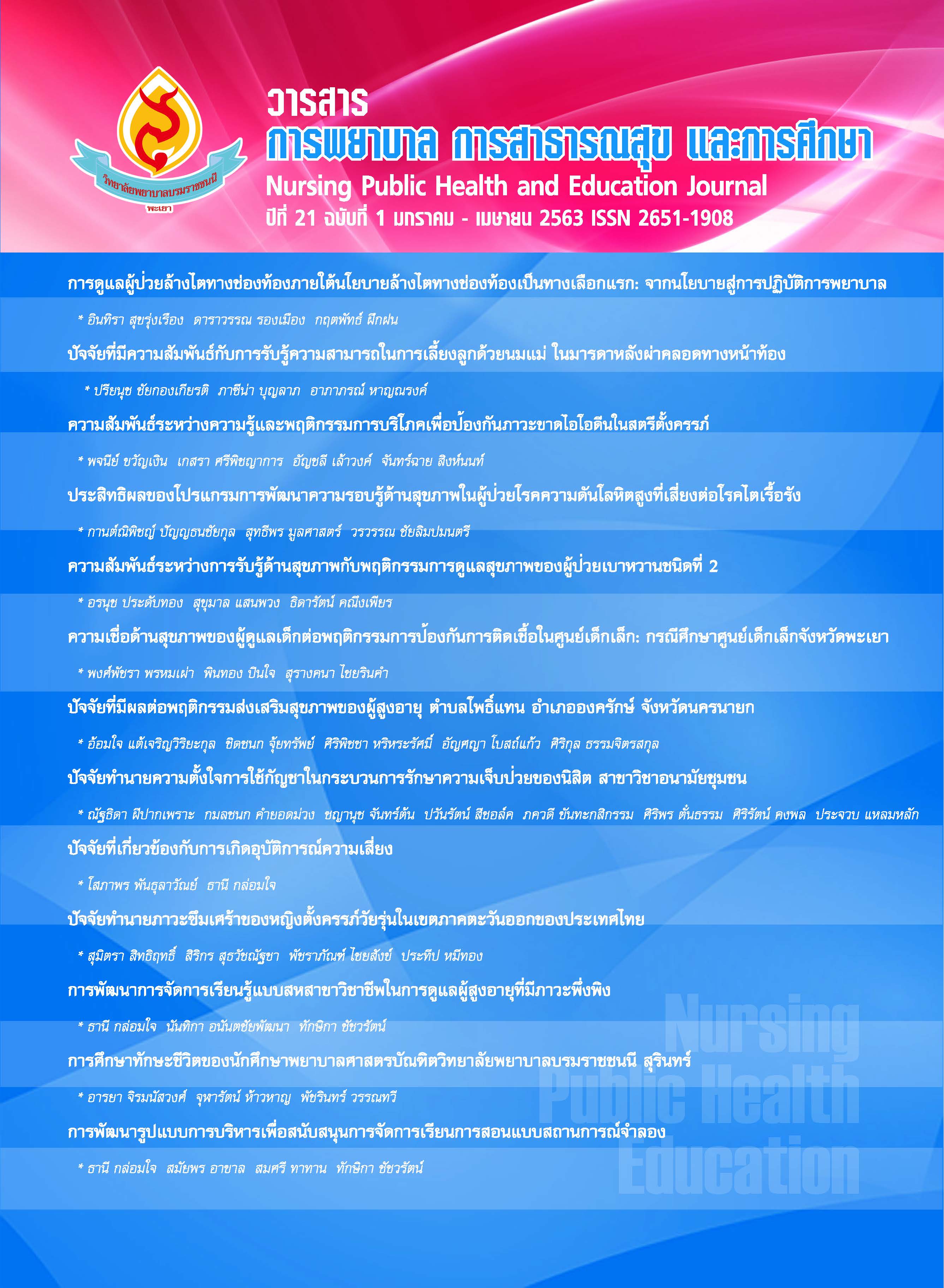ปัจจัยทำนายความตั้งใจการใช้กัญชาในกระบวนการ รักษาความเจ็บป่วยของนิสิต สาขาวิชาอนามัยชุมชน
คำสำคัญ:
ความตั้งใจการใช้กัญชา, กระบวนการรักษาความเจ็บป่วย, นิสิตสาขาวิชาอนามัยชุมชนบทคัดย่อ
การวิจัยเชิงพรรณนาครั้งนี้ มีวัตถุประสงค์เพื่อศึกษาปัจจัยทำนายความตั้งใจในการใช้กัญชาในกระบวนการรักษาความเจ็บป่วยของนิสิตสาขาอนามัยชุมชน คณะแพทยศาสตร์ มหาวิทยาลัยพะเยา ประชากรในการศึกษาคือนิสิตสาขาอนามัยชุมชน ชั้นปีที่ 1–4 จำนวน 768 คน กำหนดขนาดโดยใช้สูตรของ Taro Yamane ได้กลุ่มตัวอย่าง จำนวน 264 คน คัดเลือกกลุ่มตัวอย่างการสุ่มแบบแบ่งชั้นภูมิ (Stratified Sampling) เก็บข้อมูลโดยใช้แบบสอบถามที่ผ่านการประเมินคุณภาพจากผู้ทรงคุณวุฒิจำนวน 3 ท่านและการทดลองใช้ วิเคราะห์ข้อมูลโดยใช้สถิติ ความถี่ ร้อยละ ค่าเฉลี่ย ส่วนเบี่ยงเบนมาตรฐาน และสถิติวิเคราะห์ การถดถอยเชิงเส้นพหุ ผลการวิจัยพบว่า กลุ่มตัวอย่างส่วนใหญ่เป็นเพศหญิง คิดเป็นร้อยละ 90.9 อายุ 21 ปี คิดเป็นร้อยละ 34.4 นับถือศาสนาพุทธ คิดเป็นร้อยละ 93.9 กำลังศึกษาอยู่ในระดับชั้นปีที่ 4 คิดเป็นร้อยละ 33.7 ส่วนใหญ่ ไม่มีโรคประจำตัว คิดเป็น ร้อยละ 90.2 ไม่มีประวัติการแพ้ยาคิดเป็นร้อยละ 91.3 และ ไม่มีประวัติการเจ็บป่วยในครอบครัว คิดเป็นร้อยละ 85.6 ทัศนคติต่อการใช้กัญชาในกระบวนการรักษาความเจ็บป่วยและการคล้อยตามกลุ่มอ้างอิงต่อการใช้กัญชาในกระบวนการรักษาความเจ็บป่วยในภาพรวมอยู่ในระดับปานกลาง การรับรู้ความสามารถในการควบคุมพฤติกรรมต่อการใช้กัญชาในกระบวนการรักษาความเจ็บป่วยและการรับรู้ความยุ่งยากต่อการใช้กัญชาในกระบวนการรักษาความเจ็บป่วย ในภาพรวมอยู่ในระดับสูง ความตั้งใจต่อการใช้กัญชาในกระบวนการรักษาความเจ็บป่วยในภาพรวมอยู่ในระดับปานกลาง ปัจจัยที่มีผลต่อการทำนายความตั้งใจการใช้กัญชาในกระบวนการรักษาความเจ็บป่วย อย่างมีนัยสำคัญที่ระดับ 0.05 คือ อายุ ทัศนคติต่อการใช้กัญชา การคล้อยตามกลุ่มอ้างอิง และการรับรู้ความสามารถในการควบคุมพฤติกรรม ( R = 0.597 , F = 15.599 , R2 = 35.64 %)จากผลการวิจัยครั้งนี้พบว่า อายุ, ทัศนคติ, การรับรู้ความสามารถในการควบคุมพฤติกรรมและการคล้อยตามกลุ่มอ้างอิง สามารถทำนายความตั้งใจในการนำกัญชาไปใช้ในกระบวนการรักษาความเจ็บป่วยได้ ดังนั้น หากกระทรวงสาธารณสุขจะส่งเสริมให้นักวิชาการสาธารณสุขสามารถนำกัญชาไปใช้ในกระบวนการรักษาความเจ็บป่วยให้เกิดประสิทธิภาพสูงสุด ควรจัดอบรบให้ความรู้,ทัศนคติในเชิงบวกทั้งจากทฤษฎีและจากบุคคลต้นแบบต่างๆ ที่นำกัญชาไปใช้ในทางการแพทย์ ทำให้เกิดความตั้งใจที่จะนำกัญชาไปใช้ในกระบวนการรักษาความเจ็บป่วยได้อย่างถูกต้องและเหมาะสม
เอกสารอ้างอิง
กรมการแพทย์ กระทรวงสาธารณสุข. (2562). คำแนะนำการใช้กัญชาทางการแพทย์. สืบค้นเมื่อวันที่ 29 กรกฎาคม 2562, จาก: http://www.dms.moph.go.th.
คณะอนุกรรมการพิจารณาข้อมูลเกี่ยวกับการใช้กัญชาทางการแพทย์ คำแนะนำสำหรับแพทย์ การใช้กัญชาทางการแพทย์. สืบค้นเมื่อ วันที่ 8 เมษายน 2563, จาก: https://tmc.or.th/pdf/fact/guideline_cannabis_101062.pdf.
ณัชญ์ธนัน พรมมา. (2556). ปัจจัยที่มีอิทธิพลต่อความตั้งใจซื้ออาหารเพื่อสุขภาพของผู้บริโภคในเขตกรุงเทพมหานคร. สืบค้นเมื่อ วันที่ 4 สิงหาคม 2562,จาก: http://dspace.bu.ac.th/.
ณัฏฐ์ ใจคำปัน. (2555). ปัจจัยที่ใช้ทำนายความตั้งใจในการดื่มแอลกอฮอล์ของนักเรียนระดับชั้นมัธยมศึกษาตอนต้นในเขตตำบลสันทรายหลวง อำเภอสันทราย จังหวัดเชียงใหม่. สืบค้นเมื่อ วันที่ 4 สิงหาคม 2562, จาก: http://newtdc.thailis.or.th/ .
เนตรนภา พรมมา. (2553). ปัจจัยคาดทำนายความตั้งใจมีเพศสัมพันธ์ก่อนสมรสของนักศึกษาชายชั้นปีที่ 1 ในมหาวิทยาลัย. สืบค้นเมื่อ วันที่ 3 สิงหาคม 2562 จาก https://www.tcithaijo.org/index.php/journalup/article/view/43264
ผกาทิพย์ รื่นระเริงศักดิ์. (2562). กัญชากับการรักษาโรค. สืบค้นเมื่อ วันที่ 4 สิงหาคม 2562, จาก https://www.pharmacy.mahidol.ac.th/th/knowledge/article/453/กัญชา.
พูลสุข เจนพานิชย์ วิสุทธิพันธ์. (2558). ปัจจัยทำนายพฤติกรรมและความตั้งใจในการใช้ถุงยางอนามัยกับคู่ครอง/คู่นอนของผู้ติดเชื้อเอชไอวี/ผู้ป่วยเอดส์. สืบค้นเมื่อ วันที่ 4 สิงหาคม 2562, จาก https://www.kmutt.ac.th.
วรนันท์ คล้ายหงส์, นารีรัตน์ จิตรมนตรี และวิราพรรณ วิโรจน์รัตน์. (2559). ปัจจัยทำนายพฤติกรรมการรับประทานยาอย่างถูกต้องสม่ำเสมอของผู้สูงอายุโรคเบาหวานชนิดที่ 2. วารสารคณะพยาบาลศาสตร์ มหาวิทยาลัยบูรพา, 24(1),65-75 สืบค้นเมื่อ วันที่ 3 สิงหาคม 2562, จาก https://www.tci-thaijo.org.
วีนัส วัฒนธำรงค์, ณัฐกฤตา ศิริโสภณ, ประเสริฐศักดิ์ กายนาคา, สมบัติ อ่อนศิริ, ชาติชาย อมิตรพ่าย, อัจฉริยะ เอนก,...ภูเบศร์ นภัทรพิทยาธร. (2560). ปัจจัยที่มีความสัมพันธ์กับความตั้งใจในการใช้ยาฝังคุมกำเนิดในหญิงวัยรุ่นตั้งครรภ์ซ้ำ. 18(suplement), 102-11 สืบค้นเมื่อ วันที่ 3 สิงหาคม 2562, จาก https://www.tci-thaijo.org.
อนันต์ชัย อัศวเมฆิน. (2562). นโยบายและทิศทางการใช้กัญชาทางการแพทย์. สืบค้นเมื่อ วันที่ 9 ตุลาคม 2562, จาก https://www. hfocus.org/content/2019/09/17729?fbclid=IwAR39enIbgPJq3
อรวรรณ น้อยวัฒน์. (2557). ข้อควรรู้เกี่ยวกับพระราชบัญญัติวิชาชีพการสาธารณสุขชุมชน พ.ศ. 2556. สืบค้นเมื่อวันที่ 3 สิงหาคม 2562, จาก https://www.stou.ac.th/Schools/Shs/booklet/book574/Q&A574.pdf
Fishbein, M. & Ajzen, I. (1980). Some unresolved issues in theories of beliefs, Attitudes, and Values. In H.E. Howe, Jr, & M.M.Page (Eds.), Nebraska symposium on motivation, vol.27: attitude, values, and beliefs. (pp. 261-304). Lincon: University of Nebraska Press.
Gregg, J. G., (2011). Predicting and changing behavior: the reasoned action approach. Retrieved October 2, 2019, from: https://www.tandfonline.com/doi /full.
Marijuana. (2559). โทษของกัญชา. สืบค้นเมื่อ วันที่ 29 กรกฎาคม 2562, จาก https://sites.google.com/site/marijuana2559/thos-khxng- kaycha.
Rezvanfar, A., Ghorbanian, M., & Shafiee, F. (2014). An investigation of the behaviour of agricultural extension and education engineering students in Tehran University towards employ ability. Procedia - Social and Behavioral Sciences,152, 65 – 69.
ดาวน์โหลด
เผยแพร่แล้ว
รูปแบบการอ้างอิง
ฉบับ
ประเภทบทความ
สัญญาอนุญาต
ลิขสิทธิ์ (c) 2020 วารสารการพยายาล การสาธารณสุข และการศึกษา

อนุญาตภายใต้เงื่อนไข Creative Commons Attribution-NonCommercial-NoDerivatives 4.0 International License.



